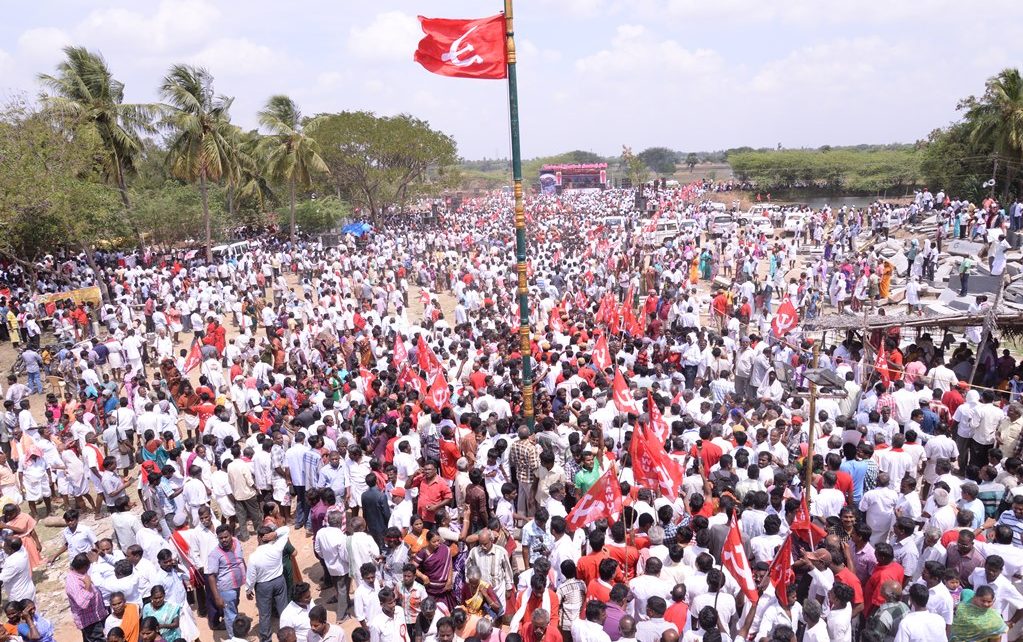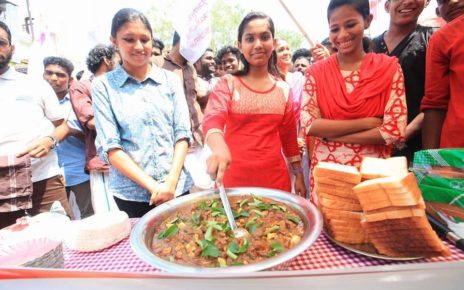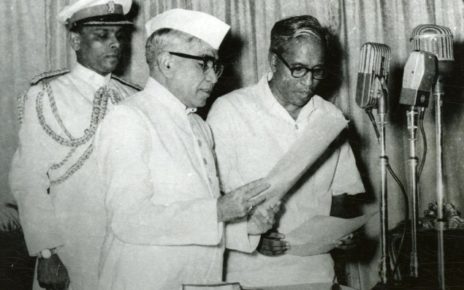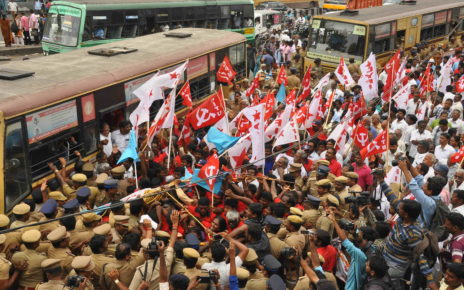25 December 2019 marks the 51st anniversary of the Keezhvenmani massacre, where 44 Dalit agricultural workers were killed by feudal landlords in Keezhvenmani village of Tamil Nadu. Anticaste.in republishes an article by Vijoo Krishnan, Joint Secretary of the All India Kisan Sabha (AIKS), who wrote the piece after visiting Keezhvenmani in August 2017.
Bedtime stories for children often conceal the real lores of the land that talk of oppression and resistance, the blood and fire involved while painting a rosy picture of society where people ‘live happily ever after’. What would it be like for the children who lived oppressed lives, faced humiliation, violence, untouchability and discrimination? The bedtime stories that I heard as a child did have stories of oppression and struggle against it; it had stories of hope and bonds of love that cut across divisions of caste, class and creed and questioned the injustices perpetuated in their name. If the stories of intense oppression and the inspiring struggle of the people of Kayyur and Karivellur against it or about the regressive practice of breast tax, discrimination against the workers and landless peasants, historically oppressed castes and women were not told it would have turned me into a vegetable that could be cooked as the dominant forces would want it to be. Bedtime stories often are part of manufacturing consent and obeisance for the oppressive system. Lores of the land need to be told as raw as it is to the generations that come. The memories of oppression and struggles against it, the defeats and victories and the hope that organisation and united struggles exude must never be allowed to die. Keezhvenmani is one such story that needs to be told again and again with a clear message ‘don’t forget; don’t forgive’. Humans should be told about barbarism as real as it was that nothing shall be seen as more despicable. My little girl shall hear the story of Keezhvenmani the next time I get an opportunity to put her to sleep.
It is in a drought year deemed the worst in over a century and a half that I reached Thanjai better known as Thanjavur in the Cauvery Delta. As we drove from the centre of the Cholas to Keezhvenmani in the Kizhvelur Taluk of neighbouring Nagapattinam district the big temple or the Brihadeswara temple, a world heritage monument had an imposing presence to our left. As it had been with the many places that I had visited over the week the rain greeted us even in this temple town. On two sides of the road we could find tell-tale signs of the once famous rice-bowl which the drought had rendered barren. As we crossed Kizhvelur and turned left towards Keezhvenmani we could see a memorial in the form of a gateway erected on the 25th anniversary of the massacre of 44 Dalit agricultural workers by feudal landlords reminding people of the gruesome incident that took place in 1968. We soon reached the premises of Ramaiahvin Kudisai (the hut of Ramaiah) where the gruesome massacre had taken place. In 1969 the then Deputy Chief Minister of Bengal Jyoti Basu had laid the foundation for a memorial to the martyrs. A black granite martyrs’ column on a stellar base inscribed with the names of the 44 killed topped with the red flag of the toiling masses stands there. The hut has been converted into a memorial and a red granite sculpture carved out of a single stone representing the plantain bud has been installed in memory of the dead. A larger memorial called Mani Mandapam just adjacent to the Ramiah’s hut was started with the contributions of the organised working class as per a decision of the Centre of Indian Trade Unions (CITU). The memorial that aims to tell the story of the oppression, struggle, resistance and sacrifices of the people is surrounded by 44 granite pillars representing each of the martyrs. Raised fists of men, women and children carved in granite adorn these pillars. The entrance to the memorial hall has a sculptured mural depicting the macabre incident that will make an indelible mark on people visiting the place.
Mythili Sivaraman’s effective chronicle of the incident and narration by comrades acquainted me with the incident. The carnage was the background for the 1977 Sahitya Akademi award winning novel Kurudhippunal (River of Blood), by Indira Parthasarathy. This was made into a film Kann Sivanthaal Mann Sivakkum (If The Eye Turns Red The Earth Shall Turn Red) in 1983. The massacre was the main subject of the 1997 Tamil language movie Aravindhan. In a 2006 documentary film, Ramaiahvin Kudisai (The Hut of Ramaiah) the survivors told their stories. The 2014 novel The Gypsy Goddess by Meena Kandasamy is also based on this incident. I would attempt to narrate the incidents through the eyes of Sethupathi, an eye-witness who had to go through it as a 13 year old, Anna Durai, another witness who was seven years old when the incidents took place, and Manoharan, the District Secretary of the CPI(M) who still vividly remembers the charred bodies heaped in bullock carts being taken to Nagapattinam which he saw as a little boy. Mythili Sivaraman’s valuable account of the carnage is, however, the inspiration for the visit and the basis for this retelling.
The ‘Party of Untouchables’ Resists Feudal Oppression
Five decades ago Keezhvenmani was a nondescript village in the midst of beautiful lush green paddy fields of East Thanjavur in the Cauvery Delta. Thanjavur being endowed with assured irrigation from the Cauvery had taken to the Green Revolution techniques in the first flush of its adoption. The rice-bowl as it was called is said to have accounted for a third of the State’s paddy production. Landlord oppression continued unabated in the region retaining all the barbarism of the feudal age. According to the 1961 census, 3.8 per cent of the cultivating households owning more than 15 acres each, held 25.88 per cent of the cultivated area while 76 percent owning up to 5 acres each possessed only 37 percent of the cultivated area. In addition to the most skewed land ownership pattern Thanjavur also had the highest proportion of landless labourers at 9 labourers for every 10 cultivators. The 1971 census found that as opposed to the State average of 29 percent landless Thanjavur had 41 percent of the rural population as landless labourers with the highest percentage of Dalits among the landless (Mythili Sivaraman, 1973). Temple trusts also held large tracts of land which was largely a preserve for the upper caste landed class who secured lease over such land and could get the landless oppressed castes to work on it by exercising their socio-economic as well as political power. Growing land struggles by the peasants organised by the Left in Thanjavur and elsewhere had led to the abolition of the Zamindari system and two legislations namely the Tanjore Pannaiyal (bonded labourers) Protection Act, 1952 and the Tamil Nadu Tenants Protection Act, 1955 were passed sending shock-waves across the feudal families. It was in such a setting that a decisive struggle for land, wages and dignity was fought in Keezhvenmani with far reaching consequences.
Keezhvenmani was predominantly a village of Dalit agricultural workers who were forced to work on the fields of the oppressor landlords who literally had a stranglehold over the best lands in its vicinity. They were bonded to the landlords and had to render services of the entire family as attached labourer for a pittance. The oppressive working conditions were reinforced by most inhuman punishments. According to the villagers all the depredations of the oppressive caste system were also in operation in the entire region. Untouchability, forced labour, prohibition from using the wells and tea shops, brutal punishments like whipping, force-feeding cow dung, sexual exploitation of women, denial of educational opportunities and prohibition of access to public places like temples were the norm. Dalits were not allowed to wear upper body clothing, had to walk barefoot and women were not allowed to cover their breasts. Legislations to protect the tenants were not effectively implemented and although technically it freed them from bondage they were in reality far from free. They continued to lead near slave-like existence as exploited daily wage workers with no rights over land or any role in deciding wages for their toil. It is this oppressive system that the Communist Party of India (Marxist) openly challenged shaking the very roots of the feudal landlordism. The Communist Party had been working in the region from the forties with leaders like V. Srinivasa Rao, P. Ramamurti, V.P. Chinthan and even A.K. Gopalan visiting Thanjavur. The Party itself was so intrinsically identified with the Dalits that it was called the Paraiyan Katchi or ‘Party of Untouchables’ often derisively by the enemies of the people. The oppressed castes whom the Hindu religion branded as polluting untouchable castes took to the red flag as fish to the water. The derision of the exploiting classes from the higher castes was taken by the Party as recognition of its commitment to its core masses. Resistance grew and the seeds of rebellion against the oppressive feudal landlordism were sown across the region.
The Green Revolution with High Yielding Varieties and the resultant rise in productivity of paddy was palpable across the Cauvery Delta. While this brought in prosperity for the landlords, the conditions of those who tilled the land and worked the land remained dismal as ever. The landless peasantry and agricultural workers under the influence of the Communist Party organised themselves for higher wages. The demand grew shriller as paddy prices in the market rose and the workers were unable to feed their families with their meagre earnings. The agricultural workers of Thanjavur District formed a Union in 1968 to articulate this main demand and to seek better working conditions. Questioning caste oppression, corporal punishments, forced labour and illegal exactions, exploitation and discrimination were earlier unthinkable, but now that became the norm. The new-found courage arising out of organised strength led to open defiance of the feudal lords. Red flags were hoisted on their humble dwellings in many villages across the region. The landlords did not take things lying down. They increased attacks, and organisers of the Party were eliminated as deterrence, to show what would happen if workers joined the Agricultural Workers’ Union. The landlords organised under the leadership of the notorious Irinjur Gopal Krishna Naidu and the Nel Utpathiyaalal Sangham or Paddy Producers’ Association was formed. Irinjur Gopal Krishna Naidu, the Mirasdar, and his family who owned over 210 acres of land and much more in benami holdings was actively involved with the Congress Party according to Sethupathi. Under his leadership the landlords insisted that the red flags be taken down in the villages of Nagapattinam and asked the labourers to hoist the yellow flags of the Paddy Producers’ Association.
In the second half of 1968 as the Green Revolution techniques saw increased yields the landlords were raking in huge profits while the agricultural workers were given only five and a half padi of rice as wages. Padi is a local measure equivalent to one and a half kilogram. So all that they got for their toil in the harvest season was 8.25 kg of rice and often even this was denied under various pretexts. It was only natural that the landless agricultural labourers from the Dalit community overwhelmingly came to be organised under the Red Flag and the Agricultural Workers’ Union. They demanded an increase in wages by half a padi to 6 padis, and the peasantry withheld part of the harvest seeking to bargain for a just wage. The landlords resorted to laying off workers who organised under the red flag. The agricultural workers organised themselves and struck work demanding increase in wages as well as expressing solidarity with the strike of Central Government workers and against the killing of a CPI(M) activist. Workers were forced to pay a fine of Rs. 20/- and only then were they allowed to resume work. Soon the demands increased; landlords demanded that all forsake the red flag and become members of the Paddy Producers’ Association or pay a fine of Rs. 250/-. Unprecedented unity of the agricultural workers was exhibited and they rejected these demands of their oppressors. Resilient defiance in the face of extreme repression further angered the landlords. They pushed the landless peasantry into starvation by severely constraining the flow of foodgrains to the local markets. They also resorted to getting labourers from outside the district to work on their land. The association of the landlords started making labourers from outside available to their members. The Agricultural Workers’ Union resisted this, leading to a constant state of conflict in the region. Three leading organisers of the Agricultural Workers Union who were active in the CPI(M) were killed, and attacks using police and goons to suppress the rebellion was unleashed. Repeated letters by CPI(M) leaders to the police authorities and a letter from P. Ramamurti even to the Chief Minister Anna Durai seeking police protection to agricultural workers was met with indifference.
Feudal Model of ‘Shock and Awe’
The red flag spread from village to village, and organised resistance shook the very foundations of the economic, social and political stranglehold of the landlords. Hardened as they were by the age-old oppressive system, the landlords chose violent retribution rather than conciliation. On 25 December 1968, the landlords resorted to kidnapping of four of the organisers of the Agricultural Workers Union – Muthuswamy, Munian Iyer, Srinivasan and Munian. They were kept under forcible confinement and brutally tortured for refusing to stop organising the agricultural workers under the red flag. The agricultural workers mobilised and successfully forced the release of these four comrades of theirs. In the ensuing clash, one of the henchmen of the landlords (also claimed to be a labourer brought from outside) named Pakkiriswamy Pillai succumbed to injuries. The fact that the most oppressed castes who were historically forced into submission had raised the flag of revolt, sparking a movement across the region, was unacceptable to the feudal landlords. They felt that the rebellion had to be nipped in the bud if their survival had to be guaranteed. Sethupathi narrates that Keezhvenmani was specifically targeted citing this pretext to send a message to all who dare to rebel.
According to him, as dusk turned into night, the landlords led by Irinjur Gopal Krishna Naidu and his henchmen descended on Keezhvenmani in police trucks by around 10 pm, and encircled the village leaving almost no scope for escape. Armed with sharp weapons and firearms, they attacked randomly and burnt many huts. Two of the landless peasants were shot dead. In the wake of increasing tension with the landlords, the landless had accumulated stones to be used as weapons as a last resort for defending themselves. In the thick of darkness that was no match for the lethal arms of their oppressors. Some including Sethupathi managed to flee amidst the melee and hid in the nearby paddy fields. He shivers when he recollects what he saw a stone-throw away from Ramaiah’s hut situated adjacent to his own dwelling. Women, children and aged had taken refuge in Ramaiah’s hut. The attackers had come prepared to burn down the village and the police trucks that brought them to Keezhvenmani were laden with inflammable liquid, he said. The hut was set on fire heeding neither to the cries of the innocent people locked inside nor to reason. It is now part of folklore that two children thrown out of the burning hut were thrown back by the killers who rejoiced as the fires raged even as they stoked it with hay and dry wood. Six people apparently managed to wriggle out of the burning hut but two of them were hacked to death and thrown back into the burning hut. Sethupathi’s brother Nandan, then in his mid-twenties, was one of the survivors and eye-witness to the barbarism. The carnage had led to the death of 44 people of whom 16 were women, 23 were children and five were aged men. All that remains of their charred remains is what was collected by one of the early visitors to the site and is preserved in a small glass case kept at the memorial.
The feudal landlords who led the attack apparently marched to the police station after the heinous act and demanded protection against possible retaliation. While repeated letters seeking protection for the activists of the Party and the Dalit agricultural workers were ignored immediately preceding the massacre, the perpetrators of the crime were given ready police protection. The complicity of the police in the entire incident has also been raised by the villagers who pointed to the fact that the attackers were herded in police trucks and brought in a planned manner to Keezhvenmani. The police inaction was clear as they claimed to know of the incident only the morning after, despite the fact that there was a police station in close proximity to Venmani. The act was well planned by the feudal landlords, meant as “shock and awe” to reinforce their hegemony as well as to force the workers back into submission. The act did shock; it stirred the conscience of people across the State. It also forever put an end to the awe and fears that the oppressed had for the landlords, and organisation gave the courage to unitedly fight and emerge victorious against all odds.
Reinforcing Injustice: Media, State and Courts of Law
The Keezhvenmani incident occurred in the second year after the doyen of the Dravidian movement Anna Durai became the Chief Minister of Tamil Nadu. The Dravidian movement had been built around a narrative of fight against oppression, and Anna himself had used to good measure films as a medium for propagating political views. His first movie Nalla Thambi promoted cooperative farming and abolition of Zamindari system. His novel Velaikari about a servant maid in 1949 which was made into a movie later was also clearly against oppression of the landlords who were portrayed as aligned with the Congress. The DMK also had come to power by promising 3 measures of rice for a rupee by procuring surplus produce from those holding more than 40 acres and distributing it (Mythili Sivaraman, 1970). Ironically, one of the much used couplets in the DMK campaign was addressing the wage question wherein the lament of a widow of a worker who is killed for demanding higher wages caught the imagination of the toiling masses. It goes thus:
My Love, he asked for a tiny rise (sic.) in wages,
My love, he slumped dead with a bullet in his guts!
(Mythili Sivaraman, 1970).
Drawing from the Dravida Kazhagam background and his association with Periyar, Anna’s writings and rhetoric were also anti-Brahminical. However, in the wake of the Keezhvenmani developments, he failed to protect the Dalit workers from attacks and mocked at P. Ramamurti’s call for police protection for them. Ironically, an earlier letter to him written by the Thanjavur District Secretary of the Agricultural Workers Union seeking protection was acknowledged in January, days after the massacre. Although he promised action after the massacre, and two Cabinet Ministers including then PWD Minister M. Karunanidhi and Law Minister Madhavan visited Keezhvenmani, no action was forthcoming. Rather, the DMK seemed unwilling to upset the status quo, and police protection was provided to the perpetrators of the crime although the main accused were aligned with the Congress. The government appointed the Ganapathi Pillai Commission to ease the tension between labourers and landlords. However, even as it had just begun its deliberations, the landlords threatened to let 8 lakh acres of land lie fallow if they were not granted protection. The Dravidian party sent a large police force to the fields on the pretext of security, while the actual intent was to prevent unionisation and agitations by Dalit agricultural workers. The Commission recommended a meagre 10 percent increase in wages, which was a pittance and did not come near a ‘living wage’ (Mythili Sivaraman, 1970).
The legal battle was also unequal. The Nagai Sessions Court which looked into the killing of Pakkiriswamy Pillai and the Keezhvenmani Massacre simultaneously ruled that the first was not a planned attack while the second was a deliberate preconceived act. In the first case one of the accused was given life sentence and seven others were sentenced to rigorous imprisonment for varying periods. In the second case ten of the landlords including Irinjur Gopal Krishna Naidu were convicted for involvement in the massacre and sentenced to 10 years of rigorous imprisonment. The Madras High Court which heard both cases upheld the ruling in the first case but quashed the ruling on the massacre! In 1973, the ‘learned’ judges of the Madras High Court ruled thus:
“… there was something astonishing about the fact that all the 23 persons implicated in the case should be mirasdars. Most of them were rich men, owning vast extent of lands and Gopala Krishna Naidu possessed a car. However much they might have been eager to wreak vengeance on the kisans, it was difficult to believe that they would walk bodily to the scene and set fire to the houses, unaided by any of their servants. They were more likely to play safe, unlike desperate hungry labourers. One would rather expect that the mirasdars, keeping themselves in the background would, send their servants to commit the several offences which according to the prosecution the mirasdars personally committed… The evidence did not enable Their Lordships to identify and punish the guilty” (Mythili Sivaraman, 1973).
Ramaiah’s hut with 44 men, women and children burnt with cries that Sethupathi says he can still hear, but the ‘Honourable’ Courts literally ruled that those who lit the fire were not aware of the presence of people in that hut. It is also said that questions were raised as to how so many people could huddle together in an 8 ft X 9 ft hut, and how was it possible that no one escaped. Such insensitivity also points to the caste-class biases that condition even the higher echelons of the judiciary.
Many have pointed out the biased role of the media. The sole exception was Theekkathir, the organ of the CPI(M), which alone carried detailed reports explaining the ground realities. Most others did not reflect the oppression, the caste-class dimensions and resistance against feudal landlordism that preceded the incident. It was reported as a conflict between two groups of farmers. This was pointed out by Mythili Sivaraman who noted: “The newspapers had informed us at that time that as labourers persisted in demanding wage increases year after year, the landowners exercised their ‘constitutional right’ to hire labour from wherever they liked. Outside labour was imported; local labour attacked outside labour; the poor fought the poor. What else could you expect from illiterate, uncultured labourers” (Sivaraman, 1973).
Even when the Madras High Court passed the verdict, it was only the Left mass and class organisations, especially the Centre of Indian Trade Unions (CITU), that marched protesting the injustice. Even the basic act of providing solace to the bereaved families, let alone effecting any tumultuous social transformation was not forthcoming from others, said the villagers.
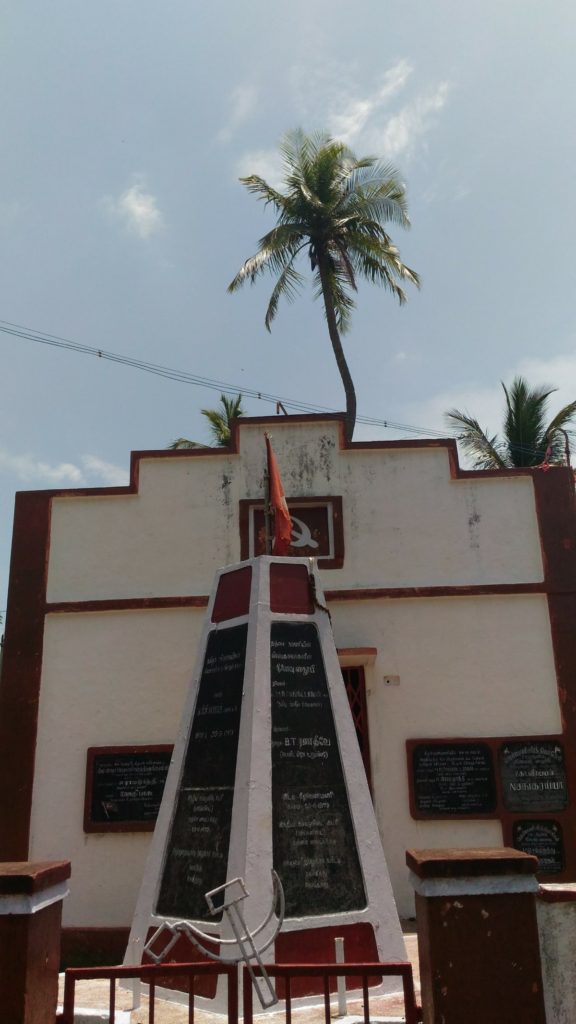
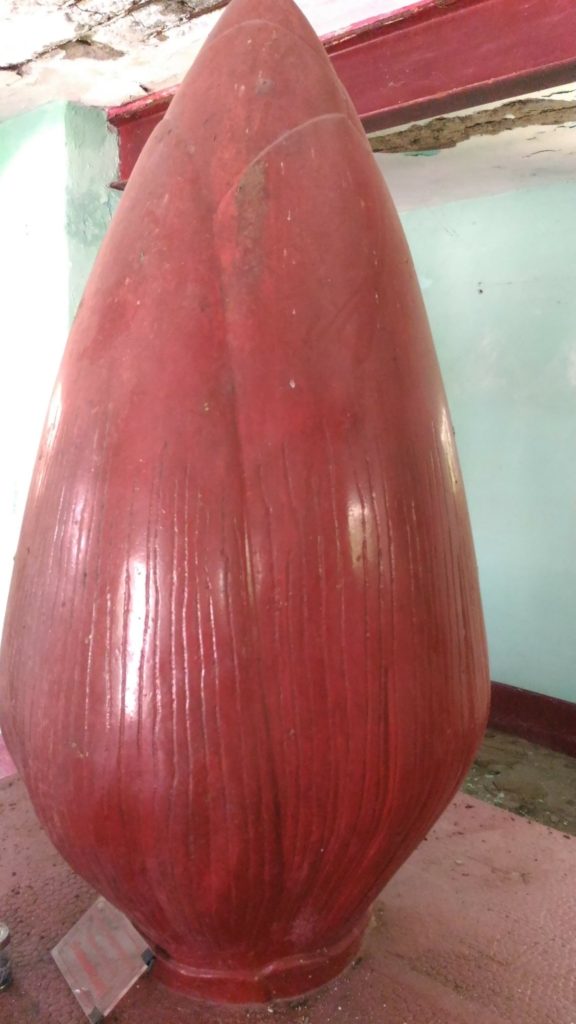
The Legacy of Keezhvenmani Lives On
In 1980, Irinjur Gopal Krishna Naidu was attacked by a group of people and hacked to death. The main accused in this case was a youth in his mid-twenties called Nandan. He was one of the eyewitnesses and survivors of the carnage. Sethupathi, the eyewitness who narrated the incident to us, was Nandan’s youngest sibling. The Communist Party and the Agricultural Workers’ Union did not merely look at Keezhvenmani as a wage dispute, it involved the land question and the struggle to end caste oppression. It was a class struggle against feudal landlordism. It was only natural that in the aftermath of the massacre, widespread struggles for changing the landholding pattern and fighting caste oppression gained momentum. The Communist Party and the Agricultural Workers’ Union became the voice of the struggling masses across Tamil Nadu. The ruling classes were forced to increase wages, and land relations had to be altered. The landless Dalit families have become cultivating peasants owning small landholdings. There has been a consolidation of the most oppressed politically around the CPI(M) and the, region remains a stronghold of the party till date. The red flag had brought them land, better wages and dignity, and ensured they could lead their lives with self-respect, said the people of Keezhvenmani. It set in motion processes for social transformation, and altered the rural setting as well as land relations by ensuring large-scale redistribution of land. The scars of oppression remain indelible on the minds and bodies of the people of Keezhvenmani. Their struggle and sacrifices ensured better wages and redistribution of land for thousands. It also hit at the roots of feudal landlordism and removed it forever from the high altar that it occupied. The people of Keezhvenmani are like tempered steel, tempered by the struggles and the fire; they shine with a confidence that they can defeat any oppressor with united struggle. Keezhvenmani calls out to all, “Let Memories Never Die”.
